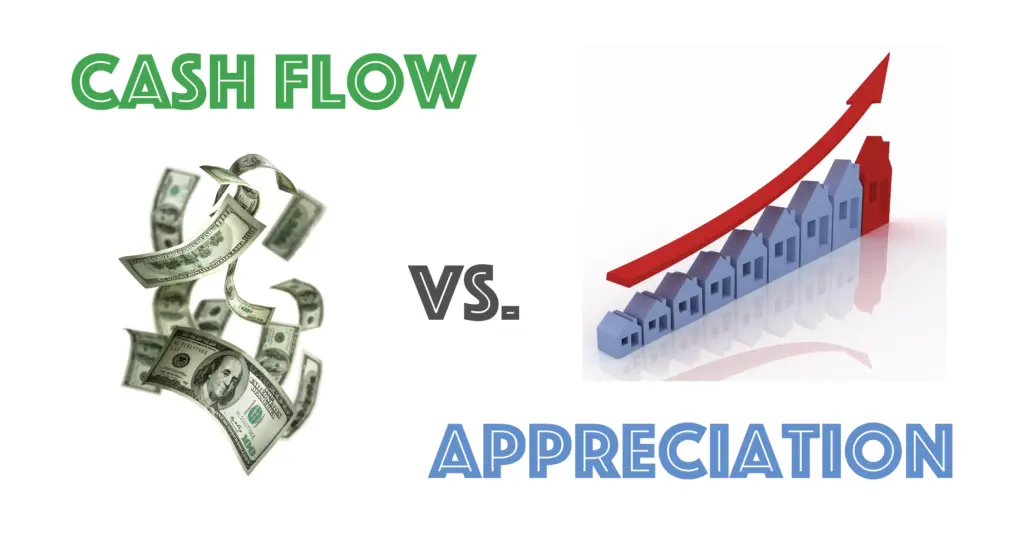When it comes to real estate, investors often hear terms like “cash flow” and “appreciation.” While both are vital components of a successful portfolio, they represent two distinct investment philosophies. Understanding the core differences between a cash flow-focused strategy and an appreciation-focused one is crucial for anyone looking to build long-term wealth in real estate. This article will break down these two approaches, explore their pros and cons, and help you determine which one aligns best with your financial goals.
Cash Flow: The Steady Stream of Income
At its simplest, cash flow is the net income an investment property generates after all operating expenses are paid. This includes mortgage payments, property taxes, insurance, maintenance, and property management fees. A property is considered to have positive cash flow when its rental income exceeds these expenses.
How it works: Investors who prioritize cash flow are typically looking for properties that generate a consistent, passive income stream. Their focus is on the monthly or quarterly return, not necessarily on a massive gain when they sell the property. This strategy is popular with investors who want to replace their earned income, cover living expenses, or simply build a steady source of passive income to achieve financial freedom.
Example: Imagine an investor purchases a duplex for $300,000. After all expenses, including a mortgage payment, the property brings in $500 per month in net income. This $500 is the positive cash flow. Over time, this consistent income can be used to pay down the mortgage, reinvest in other properties, or simply supplement the investor’s lifestyle.
Pros of Cash Flow Investing:
- Predictable Income: Cash flow provides a regular, predictable income stream, making it easier to budget and plan financially.
- Insulation from Market Swings: Even if the real estate market experiences a downturn, a positive cash flow property can continue to generate income, helping to weather the storm.
- Financial Freedom: A strong cash flow portfolio can be a direct path to financial independence, allowing you to quit a traditional job or simply have more freedom in your life.
- Mortgage Paydown: The income generated can be used to accelerate mortgage payments, reducing the debt burden and increasing equity more quickly.
Cons of Cash Flow Investing:
- Slower Equity Growth: While the mortgage is being paid down, the overall value of the property may not grow as quickly in certain markets.
- Less Lucrative in High-Cost Areas: It can be very challenging to find positive cash flow properties in expensive, high-demand markets like San Francisco or New York City, where property values are high but rental yields are often low.
- Requires Active Management: Even with a property manager, cash flow properties can require attention, especially during tenant turnovers or unexpected repairs.
Appreciation: The Long-Term Wealth Builder
Appreciation is the increase in the value of an asset over time. In real estate, this means the property’s market value grows, so when you eventually sell it, you can make a significant profit. Investors who focus on appreciation are essentially betting on the future growth of a particular market or property.
How it works: An appreciation-focused investor will often look for properties in emerging markets, areas with planned infrastructure projects, or neighborhoods undergoing revitalization. The goal is to buy low and sell high, capitalizing on market trends and economic growth. This strategy is often more speculative and requires a longer-term horizon.
Example: An investor buys a single-family home in a rapidly developing suburban area for $400,000. For a few years, the property’s rental income might just cover expenses, or it might even be slightly negative cash flow. However, five years later, due to new job growth and a scarcity of housing, the property is now worth $650,000. The investor sells the property, realizes a $250,000 profit (minus transaction costs), and reinvests that lump sum.
Pros of Appreciation Investing:
- Potential for High Returns: A successful appreciation play can result in a massive profit, far exceeding the cumulative income from a cash flow property over the same period.
- Less Active Management: Since the primary goal is long-term value growth, the day-to-day cash flow isn’t as critical, which can mean less stress about filling vacancies or minor maintenance issues.
- Access to Prime Markets: This strategy is more viable in expensive, high-growth markets where cash flow properties are hard to find.
Cons of Appreciation Investing:
- High Risk and Uncertainty: Appreciation is not guaranteed. A market could stagnate or even decline, leaving the investor with a property that is worth less than the purchase price.
- No Immediate Income: This strategy does not provide a steady income stream. The investor may need to cover expenses out of pocket or rely on other income sources.
- Requires More Capital: A higher purchase price and the potential for negative cash flow mean this approach can require more initial capital.
- Liquidity Issues: The profits are tied up until the property is sold, which can take time and effort.
Which Strategy is Right for You?
The decision between a cash flow and an appreciation strategy depends on several factors:
- Your Financial Goals: Are you seeking a steady income to replace a job or supplement your current one? If so, cash flow is likely the better choice. Are you a long-term investor with a high-risk tolerance who wants to build significant net worth over decades? Appreciation might be the way to go.
- Your Risk Tolerance: Cash flow is generally a more conservative, lower-risk strategy. Appreciation is more speculative and carries a higher risk of loss.
- Your Time Horizon: Cash flow can start paying off immediately, while appreciation requires patience and a long-term outlook.
- Market Conditions: The ideal strategy can depend on where you are investing. High-growth metropolitan areas may be better suited for an appreciation play, while rural or secondary markets with lower property values may offer better cash flow opportunities.
The Hybrid Approach: The Best of Both Worlds
Many savvy investors don’t limit themselves to just one strategy. The hybrid approach involves finding properties that offer both solid cash flow and strong potential for appreciation. This is often the “holy grail” of real estate investing.
You can achieve this by:
- Finding undervalued properties in good neighborhoods that can be improved through renovations or a cosmetic facelift. The improvements can increase the rental income (boosting cash flow) and the property’s market value (driving appreciation).
- Targeting markets that are on the cusp of significant growth but still have relatively low property prices.
- Using leverage wisely to acquire properties that meet both criteria without overextending yourself.
Ultimately, both cash flow and appreciation are essential components of real estate investing. While they represent different paths, they are not mutually exclusive. By understanding your personal financial goals and the dynamics of your chosen market, you can craft a strategy that builds a portfolio that is both profitable today and valuable for your future. The key is to start with a clear objective and make informed decisions that align with your long-term vision.




